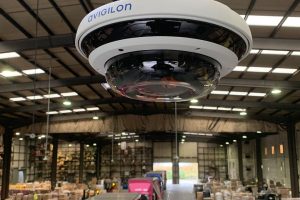Ready to upgrade your CCTV system?
Contact Us, and we’ll help build and execute your plan.
It’s pretty easy to think of a place in Alberta that is protected by a video surveillance system. They’re just about ubiquitous in major cities like Edmonton and Calgary, where they can be found on university campuses, office towers, retail environments, and industrial facilities. But, video surveillance systems can be found just as easily in places like Fort McMurray and even in the oil sands.
Unfortunately, one of the challenges many of these systems face is that they are aging, analog systems. The cabling these CCTV systems rely on can’t support high bandwidth, which means lower frame rates, grainer video, and low-resolution images. It also means security personnel, will have to spend countless, tedious hours watching security feeds because of the lack of video analytics.
If you’re starting from scratch, or in the highly unlikely situation that you have an unlimited budget, Tridon recommends you build an IP video surveillance system. If you’re just thinking of upgrading to an IP CCTV system, check out our blog to see how the two stack up against each other.
But, if you’re ready to pull the trigger on an upgrade, then start by making a solid plan. You can Contact Us if you’re looking for support to build that plan, or you can keep reading to see the most important points your plan should include.
Determine What You Really Need
This is a conversation you should have with your team and your supplier. Managers in different departments may have a better understanding of that department’s needs than you do, and your supplier will be able to provide solutions that meet their specific needs.
But broadly speaking, being clear on what exactly you want your CCTV system to accomplish will help you make the most effective use of your budget. If outdoor coverage (e.g. a parking lot, a gate to the site) is a must-have, then your provider can source cameras that can stand up to the elements while providing high-resolution surveillance in low light conditions. If minimizing response times is a top priority, then your surveillance system can be designed to send radio alerts to security personnel the instant an incident occurs.
These are just a couple of the capabilities that analog CCTV cameras can’t offer, but you’ll have to determine – and rank – your security priorities to know if they’ll provide you with real value.
Consider the Lighting Conditions
Some cameras are better suited for low-light conditions than others. Knowing which areas are likely to be dimly lit (e.g. parking lots, parking structures, warehouses after hours) can and should guide your decisions about what cameras to buy and install. There are IP cameras available that are designed specifically for low-light conditions, and some can even work in complete darkness. These cameras create an image based on the heat radiating from a person or object and record those images in the event of an incident.
Knowing what the lighting conditions are in each environment you want to be surveilled, and how they can change during the course of a day, will help you choose the right equipment for the job.
Build Your System with the Future in Mind
Your business needs are going to change over time. Renovations, expansions, or other changes in your building’s layout could force you to add cameras to your system or to relocate the cameras you have installed. An incident on site could make clear the need for new analytics features, requiring training and possibly software upgrades or add-ons. After a few months of deployment, you may suddenly realize that you have a blind spot in your system’s field of view that needs to be addressed, be it with a new camera or a repositioning of equipment you already own.
The list of reasons why your security needs could change could go on forever. Be prepared for this by designing a security system that can accommodate this need for change.
Review Your Security Policies and Provincial Legislation
The redesign of your video surveillance system is the perfect opportunity to review the policies your business has surrounding the use of CCTV cameras. Bear in mind that IP video surveillance systems are often paired with powerful video analytics software. What that means, in a nutshell, is that your security system will be collecting a lot more information. Facial and license plate recognition, one’s proximity to secured areas, and movement the system deems to be out of the ordinary is just a few of the analytics modern surveillance systems are equipped with. You’ll need to decide how much of this information you require, and your policies will have to explain to your employees just why you are collecting it.
Take this opportunity to review provincial guidelines and legislation, too. In Alberta, the Office of the Information and Privacy Commissioner has a large role in setting and enforcing the standards, so they are a great resource.
When upgrading your surveillance system, be sure you adhere to the most recent legislation. Ensure you still have a legitimate reason for using video surveillance and that you are only capturing the information you are permitted to. For example, the rules around recording audio are much stricter than simply recording video.
Rules governing where cameras can and can not be placed will also have to be adhered to. Areas where people would have a reasonably heightened expectation of privacy – like a washroom – are off-limits for recording devices, for example. Be sure to know these rules and adhere to them in your redesign.
Reach Out to An Experienced Provider
Analog CCTV cameras have been around for a while, so there’s no shortage of contractors to reach out to. But designing an IP camera system, complete with net video recorders and ethernet cabling to connect all devices, is more complicated. And, because the success of your system will rely heavily on the installation, you would be well served to reach out to an experienced provider for design and installation.
Getting Started
This was just a quick overview. Your surveillance system is essentially a part of your facility’s infrastructure and installing it (or upgrading it) is a process that requires serious planning and consideration.
As a Telecommunications System Integrator, Tridon is able to support you through the entire process of upgrading your system – from planning and design to installation and ongoing maintenance. If you have any questions, Contact Us. Our team is here to help.
Tridon is a full solution Telecom Systems Integrator with CSA certification and licensed by APEGA. Our Engineering, Service and Tower Divisions collaborate with customers to build engineered solutions including communications systems design, tower inspections, and co-location, wireless broadband, fiber optic cabling, site security, and two-way radio communication.



